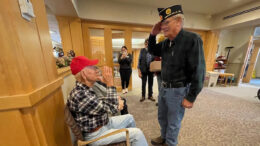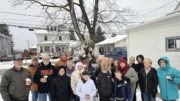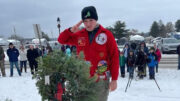As the wildfire season comes to a close, a forester with the state Department of Conservation and Natural Resources says the northwest region of Pennsylvania experienced its worst fires in five decades.
“We’ve had the most active wildfire season in the past 50 years,” said Cecile Stelter with the DCNR.
More than 1,000 wildfires have been reported to DCNR during this year’s season, which typically stretches from mid-March to mid-May, Stelter said.
Stelter has managed the Cornplanter Forest District since 2008. The district encompasses Venango, Forest, Crawford, Warren and Erie counties.
“We’ve had a lot of firsts this year and that’s not a good thing,” she said.
Stelter said this was the first time the Cornplanter district requested the help of a Bureau of Forestry Type 3 Incident Management Team to fight the Cobham and Hemlock wildfires that burned nearly 500 acres in the Tidioute and Warren areas.
The Type 3 team is typically reserved for even larger fires, but Stelter said her small staff and volunteer firefighters were overwhelmed.
“We had a single engine air tanker and we had a helicopter dropping retardant and water on those fires, and it’s the first we had to have two aircraft on a fire,” Stelter said.
Stelter said there is a misconception that Pennsylvania doesn’t have wildfires.
“They’re uncommon, but that doesn’t mean that the smaller wildfires can’t be damaging and deadly,” Stelter said. “In Vennago County someone lost their life that was attributed to a wildfire.”
The April 6 fatal brush fire at a farm near Two Mile Run County Park was the second wildfire-caused death reported in the state this year, Stelter said.
While this was a typical year in terms of acreage burned with 2,500 acres scorched statewide, this year had significantly more fires reported, according to Stelter.
“Usually we maybe see a slight increase (in fires reported), but this year I would say it’s unprecedented,” Stelter said.
One reason there were more fires in the northwest region of the state is because most of the snow had melted by the beginning of March, drying out grass and kicking off the fire season earlier, Stelter said.
She said March also began with less precipitation than normal and spring came with strong and gusty winds.
More than half the fires were started by people burning debris, Stelter said.
“When you pair that human-caused activity with very dry conditions and gusty winds, you get those fires,” Stelter said.
Stelter asked that people take necessary precautions when burning, like keeping fires small and controllable, avoiding burning on windy days, and keeping tools and water nearby, she said.
“And most of all, people need to stay with the fires. If they light it… stay with it,” Stelter said.
“It’s not unusual that we respond to fires that people think are out for a couple days,” Stelter said. “As long as you can’t feel any heat, then you are usually pretty safe.”
Stelter said she asks people to follow these guidelines to keep from adding to fire department’s workloads.
“Why this is important is because the people who are going out and fighting these are the volunteer fire departments,” Stelter said. “Wildfires are just another thing they have to respond to help their community.”
Stelter attended the April gathering of the Venango County Firefighters and Fire Chiefs Association to thank the firefighters for their help battling the wildfires.
“I have a small staff so I am very, very appreciative of the volunteers and that support that they give to us, so I just can’t give enough support to them,” Stelter said.
Stelter said the firefighters were able to contain the large Cobham and Hemlock wildfires with no injuries or damaged structures.
“They didn’t even lose an outhouse,” Stelter said.































